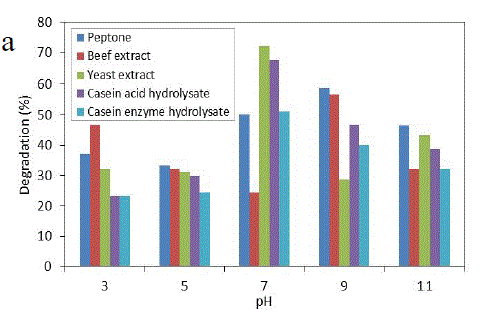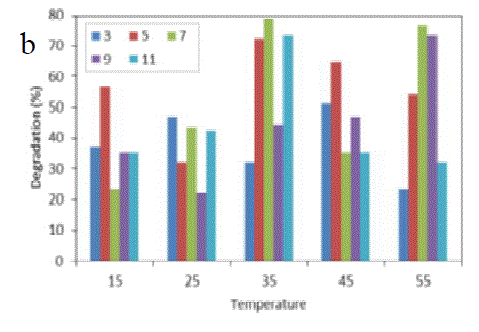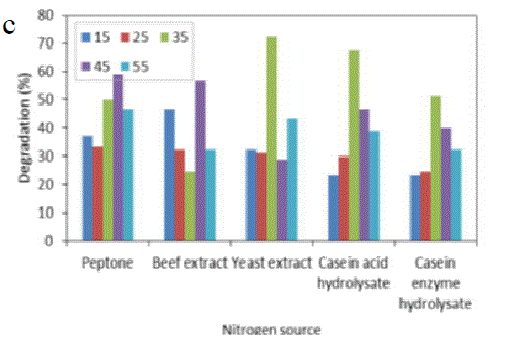ISSN ONLINE(2319-8753)PRINT(2347-6710)
ISSN ONLINE(2319-8753)PRINT(2347-6710)
Prabhakaran. P1, Sureshbabu. A1, Rajakumar. S2 and Ayyasamy. P.M3*
|
| Related article at Pubmed, Scholar Google |
Visit for more related articles at International Journal of Innovative Research in Science, Engineering and Technology
Soil contamination with oil spills is the major global concern today. It has a serious hazard to human health, causes organic pollution of ground water which limits its use, causes economic loss, environmental problems and decreases the agricultural productivity of the soil. To enhance removing crude oil in contaminated soil and water in laboratory scale several types of assays were performed. We assessed remediation by using bacterial consortium through improving environmental parameters and absorption studies through coir waste. Total petroleum hydrocarbons (TPH)-contaminated soil samples were collected from oil polluted areas in Namakkal and Salem districts. Based on the first assessed suitable environmental parameters improve the remediation process up to 78%. The second evaluated the absorption of oil with coirpith also increases the remediation up to 98% compare to remediation through effective bacterial consortium (54%).
Keywords |
| Crude oil, optimization, coir waste absorption, adsorption kinetics. |
INTRODUCTION |
| The contamination of soil and groundwater by hazardous chemicals has become a major concern due to the associated risks to human health and the environment [5]. One hundred years ago oil exploitation began, first as a source of energy and later to include oil as a source of raw material. As a source of energy, crude oil went through an uninterrupted progression of its extraction during more than one century, driven by development of transport and industry. Crude oil is composed of hundreds of compounds [2]. India’s oil and gas sectors meet around 42% of the country’s primary energy demand and contribute over 15% to the gross domestic product. Oil spill accidents are very common in the areas near the seashore because of shipping of oil tankers and bursting of oil supply pipelines. Recently in India, Mumbai-Uran oil spill through the pipeline bursting witnessed about 600 metric tons spillage of crude oil which caused a widespread mortality of sea animals. Oil contamination of soil and water from industrial sources and other activities are producing ecological disasters and addressing public concerns [4]. Petroleum hydrocarbons composed of complicated mixtures of non-aqueous and hydrophobic components such as n-alkane, aromatic, resins and asphaltenes. Due to the adverse impact of these chemicals on human health and environment, they are classified as priority environmental pollutants by the US Environmental Protection Agency [16]. Oil contamination with petroleum hydrocarbons has caused critical environmental and health defects and increasing attention has been paid for developing and implementing innovative technology for cleaning up this contamination [17]. Multiple initiatives have been developed to resolve the problem of petroleum pollution. An array of procedures has been developed including physical, chemical and biological techniques. Among these procedures, bioremediation is currently used alone or associated with physicochemical procedures. Biological methods of rehabilitation of polluted sites represent an interesting alternative. These techniques are based on the microorganism’s capacities to degrade petroleum compounds [6]. This agrees with the suggestion of onwurah [11], who reported that crude oil degrading bacteria such as Pseudomonas sp, Micrococcus sp. and Bacillus sp. could metabolize the toxic components of crude oil, leading to its degradation. In the present investigation, microbial activity in degradation and involvement of coir pith in remediation process and also studied various environmental parameters like carbon source, nitrogen source, temperature and pH affecting the remediation process. |
II. MATERIAL AND METHODS |
| A. Enumeration of bacteria from crude oil contaminated soil and water Oil contaminated soil and water sample was collected from Salem, Namakkal and Erode districts in Tamil Nadu. The microbial culture of the sample was enriched in an enrichment medium at pH 7.2 with the following compositions (g/L): MgSO4, 0.2g; CaCl2, 0.02g; KH2PO4, 1.0g; K2HPO4, 1.0g; NH4NO3, 1.0g; FeCl3, 0.05g (Difco, 1984) and Crude oil was added as the principle carbon source. One gram of soil added in a 250 ml glass flask containing 100 ml of the enrichment medium and the incubated at 37oC for 7 days in a shaking incubator at 120 rpm. After microbial growth occurred the bacterial colonies were determined by standard plating methods. Well defined morphologically different colonies were isolated and stored at 4oC. B. Identification of bacteria To identify and characterize the bacterial isolates, biochemical tests such as Gram staining, spore staining and tests for oxidation/ fermentation, MR, VP, indole and the hydrolysis of cellulose were performed according to manual of common bacterial tests (Dong and Cai, 2001). C. Oil degrading bacterial strains Five oil degrading bacterial strains (EW4, EW6, SS11, SSM2 and SSM10) previously isolated by enrichment technique were used. Isolates were stored at -80oC in LB medium supplemented with 20% (v/v) glycerol solution. The composition of LB medium was (g/L-1): NaCl 10.0; tryptone 10.0; yeast extract 5.0. The pH was adjusted to 7.0. The test isolated strains were further screened by primary (DCPIP) and secondary (Gravimetric) methods. D. Antagonistic activity Antagonistic activity of potential bacterial strains was studied by well diffusion assay to eliminate the strains which hold secretions of harmful extracellular compounds like antibiotics, cell wall degrading enzymes. Based on the inhibition results consortium formulation was made to find their efficiency on crude oil degradation. E. Effect of environmental parameters on the degradation of crude oil Degradation of crude oil by the consortium was evaluated using Mineral Salt Medium (MSM) with different carbon and nitrogen sources. The MSM consisted of (g/L-1): NaCl 10.0g; Na2HPO4 5.0g; KH2PO4 2.0g; MgSO4 7H2O 0.2g. The carbon sources evaluated were: starch, glucose, sucrose, fructose, maltose and dextrose. The different carbon sources were added to the MSM at a concentration of 10 g/L. The nitrogen sources tested were: peptone, beef extract, yeast extract, casein acid hydrolysate and casein enzyme hydrolysate, keeping dextrose as the carbon source (10 g/L). The different nitrogen sources were added to the MSM at a concentration of 10 g/L. Media were adjusted to five different pH such as 3, 5, 7, 9 and 11 were made by adjusting with 0.1N HCl and 0.1N NaOH. For optimization of various temperatures (15, 25, 35, 45 and 55) were carried out with suitable carbon and nitrogen sources. Assays were performed in 100 ml flasks containing 50 ml of the different media. Each flask was inoculated with 1% of a pre-culture grown in the same medium for 24 h. F. Gravimetric analysis Total crude oil concentration was estimated by liquid-liquid extraction method by using diethyl ether. The residual oil was extracted by solvent extraction method by using diethyl ether. The solvent layer was separated by separating funnel and dropped into preweighed petri dish and incubated at 45oC for 15-20 mins. After evaporation of solvent the remaining oil content were measured. The quantity of oil removal was assessed by following formula: |
 |
| Were; X = Oil content in after remediation, Y= Initial Oil content G. Biodegradation of crude oil by bacterial consortium percentage The mixed bacterial consortium at the log phase overnight cultures were transferred to 250 ml conical flasks containing 100 ml of sterile defined mineral salts medium with 1% crude oil. The flasks were incubated at 30oC for 20 days. At 2 day intervals, sets of flasks were used for the extraction of residual oil. The total hydrocarbons in the treatments were determined gravimetrically. H. Influence of coir waste on the biodegradation of crude oil by bacterial consortium Coir waste, a soil conditioner, contains 42% organic carbon and C: N ratio is 75:1. The pH of coir waste was 5.5. The cellulose, hemicelluloses and lignin present in coir waste were 52, 27 and 26% respectively. The MSM was prepared with optimized ingredients. Additionally 1% coir waste was added to enhance the rate of degradation. Bacterial consortium as inoculated aseptically and incubated at 35oC for 7 days. . At 2 day intervals, sets of flasks were used for the extraction of residual oil. The total hydrocarbons in the treatments were determined gravimetrically. I. Adsorption kinetic studies In order to examine the controlling mechanism of adsorption such as mass transfer and chemical reaction, several kinetic models are used to test the experimental data. The rate of adsorption of oil by coir waste was determined using two simple kinetic analyses. The first one is pseudo-first-order Lagergren’s [1] and defined as shown in equation (1): |
 |
III. RESULTS AND DISCUSSION |
| Morphologically, 131 different isolates were obtained from the contaminated water and soil samples. The isolated crude oil degrades belonged to the genera Micrococcus, Bacillus, Enterobacteriaceae, Pseudomonas, Alcaligenes, Moraxella, Acinetobacter, Vibrio and Actinomycetes. The flora reflected the normal heterotrophic bacteria present in soil and native genera seemed to be crude oil utilizes. However, the dominant strain fit in Bacillus, Listeria and Pseudomonas. Lal and Khanna (1996), Bharathi and Vasudevan (2001), Rahman et al, (2002) had already identified the above genera among hydrocarbon-degrading microorganisms. It was clear that, the crude oil resistant isolates were able to grow in crude oil contaminated water and soil. Among the isolates, 124 strains were able to grow in mineral salt medium with crude oil as a carbon source. Therefore, this study empathetically shows that every individual bacterial culture tolerated to grow in the crude oil. While comparing these studies, the bacterial strains EW4, EW6, SS11, SSM2 and SSM10 were conquered with 50, 65, 35, 35 and 35% of degraded respectively. In antagonistic study, the SSM10 had an antagonistic activity against all the other four strains. Because of this nature the SSM10 strain was mislaid from effective strains and form consortium using other four stains. Similarly SS11 strain also had an antagonistic activity against EW4. Based on the end results, 7 different consortiums were formed for crude oil remediation. In this EW4, EW6, SSM2 consortium removes 54% as maximum. The consortiums were monitored for their growth and percentage of degradation results showed that EW4, EW6 and SSM2 which was made from the three highest growing colonies have the highest growth rate. Environmental factors like the carbon source, nitrogen source, pH and temperature were applied for the degradation of crude oil. In the case of carbon source already predicted that the bacterial consortium was predominantly used dextrose as a carbon source. Hence, 1% dextrose was used for all other optimization process as a carbon source. In the above studies, the bacterial consortium degraded at a maximum level of 80.3% of crude oil in the medium optimized with suitable conditions. For example, |
 |
 |
 |
| Fig.1 Optimization of environmental parameters: a. various pH vs nitrogen souce, b. various temperature vs pH, c. various nitrogen source vs temperature. The percentage removal of the crude oil at the end of the gravimetric study is shown in fig.2. The results show that at 1% v/v, the highest degradation occurs. Moreover, the strains belonging to this consortium were identified to be from the species Bacillus subtilis (EW4), Bacillus jeotagali (EW6), Bacillus foraminis (SSM2) which are usually present in the soil. Strains belonging to these species have been widely used for hydrocarbon degradation ([15]; [14]; [10]; [13]). In this study proves the absorption was enhanced and increases the bioremediation process. Because when the coir pith used the bacterial consortium were removes oil in minimal media up to 95.5%. |
 |
| Fig. 3 Adsorption kinetic model: a. Pseudo-first order reaction of crude oil adsorption, b. Pseudo-second order reaction of crude oil adsorption. It was found that the correlation coefficient (R2) for the first-order reaction was lower than 1.0. This suggests that the adsorption of oil onto coir pith is not of first-order. The straight linear line in plot t/qt vs. t proves a good agreement of experimental data with the second-order kinetic model. Table 1 shows that the correlation coefficient (R2) for the second-order kinetic model is almost equal to 1.0. |
 |
IV. CONCLUSION |
| From the above study it was concluded that, the report predicted from the current paper clearly suggest that use of coir waste as adsorbent is much economical, effectual viable. It can be efficiently used to adsorbent with microbial consortium to remediate crude oil pollution. The different environmental parameters observed during the process of surveys revealed that the pH, temperature, contact time, process of adsorption could be essential for crude oil degradation. The batch studies clearly suggest that coir waste exhibit almost 98% adsorption at concentrations of 3 g/100ml of coir waste. The calculated value of different parameters clearly indicates that the on-going adsorption process is following pseudo second order. |
ACKNOWLEDGMENT |
| The authors are thankful to University Grant Commission (UGC), New Delhi for NON - SAP fund to accomplish this research work. |
References |
|